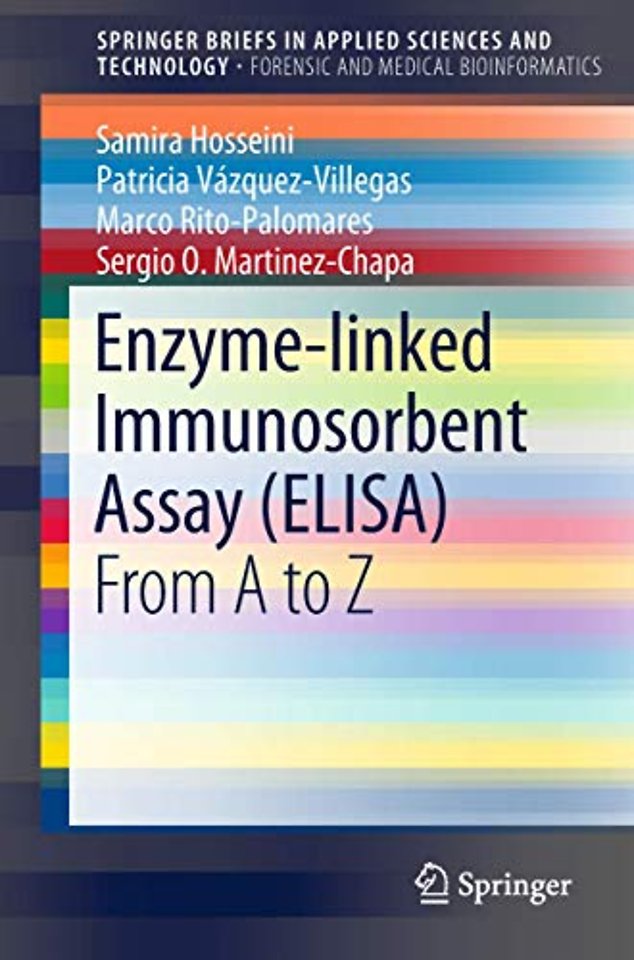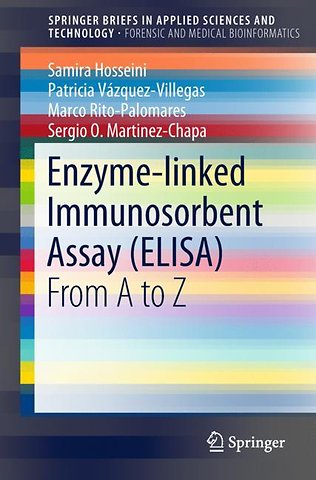Enzyme-linked Immunosorbent Assay (ELISA)
From A to Z
Samenvatting
This book offers comprehensive information on all aspects of ELISA, starting with the fundamentals of the immune system. It also reviews the history of analytical assays prior to the advent of ELISA (enzyme-linked immunosorbent assay) and addresses the materials of choice for the fabrication of the platforms, possible biomolecular interactions, different protocols, and evaluation parameters. The book guides readers through the respective steps of the analytical assay, while also familiarizing them with the possible sources of error in the assay. It offers detailed insights into the immobilization techniques used for protein attachment, as well as methods for evaluating the assay and calculating the key parameters, such as sensitivity, specificity, accuracy and limit of detection. In addition, the book explores the advantages and shortcomings of the conventional ELISA, as well as various approaches to improving its performance. In this regard, merging and integrating other technologies with widely known ELISAs have opened new avenues for the advancement of this immunoassay. Accordingly, the book provides cutting-edge information on integrated platforms such as ELISpot, plasmonic ELISAs, sphere-/bead-based ELISAs, paper-/fiber-based ELISAs and ELISA in micro-devices.
Specificaties
Inhoudsopgave
2 General overview on applications of ELISAAbstract2.1 Application of ELISA2.1.1 Food industry2.1.2 Vaccine development2.1.3 Immunology2.1.3.1 Autoimmunity2.1.3.2 Humoral immunity2.1.4 Diagnosis2.1.4.1 Home pregnancy test2.1.4.2 Cancer detection2.1.4.3 Detection of the infectious diseases2.1.5 Toxicology 2.1.6 Drug monitoring and pharmaceutical industry2.1.7 TransplantationReferences
3 Step by step with ELISA: mechanism of operation, crucial elements, different protocols, and insights on immobilization and detection of various biomolecular entities Abstract3.1 Mechanism of operation3.2 Different elements of the assay3.2.1 Solid phase3.2.1.1 Adsorption3.2.2 Washing process3.2.3 Antigens 3.2.4 Antibodies3.2.4.1 Antispecies antibodies3.2.5 Enzyme3.2.5.2 Different types of enzyme3.2.5.2 Enzyme conjugation3.2.6 Substrate3.2.7 Stopping process3.2.8 Reading process3.2.8.1 Chromogenic assay3.2.8.2 Chemifluorescenct assay3.2.8.3 Chemiluminescent assay3.2.8.4 Reading apparatus3.2.9 Controls3.3 Target biomolecular entities by ELISA3.4 Different protocols3.4.1 Direct ELISA3.4.2 Indirect ELISA3.4.3 Sandwich ELISA3.4.4 Double sandwich ELISA3.4.5 Competitive ELISA3.5 Immobilization techniques for protein attachment 3.5.1 Physical immobilization3.5.2 Covalent immobilization3.5.2.1 Immobilization via zero-Length cross linker3.5.2.2 Immobilization via spacers3.5.3 Immobilization via entrapment3.5.4 Oriented immobilizationReferences
4 Evaluation of the detection results obtained from ELISAAbstract4.1 Conducting a reliable assay4.1.1 Sources of error4.1.2 Troubleshooting 4.2 Key parameters for evaluation of the assay4.2.1 Sensitivity4.2.2 Specificity4.2.3 Accuracy4.2.4 Limit of detection4.3 Measurable units in ELISAReferences
5 Advantages, disadvantages and modifications of conventional ELISA Abstract5.1 Significance of conventional ELISA 5.2 Shortages of conventional ELISA5.3 Materials of choice for fabrication of ELISA well plates5.4 Different types of ELISA well plates5.5 Modified ELISA platforms5.5.1 ELISpot5.5.2 Plasmonic ELISA5.5.3 Sphere-/bead-based ELISAs5.5.4 Paper-/fiber-based ELISAs5.5.5 ELISA in microdevicesReferences
6 Common questions and answers about ELISA AbstractReferences Summary









